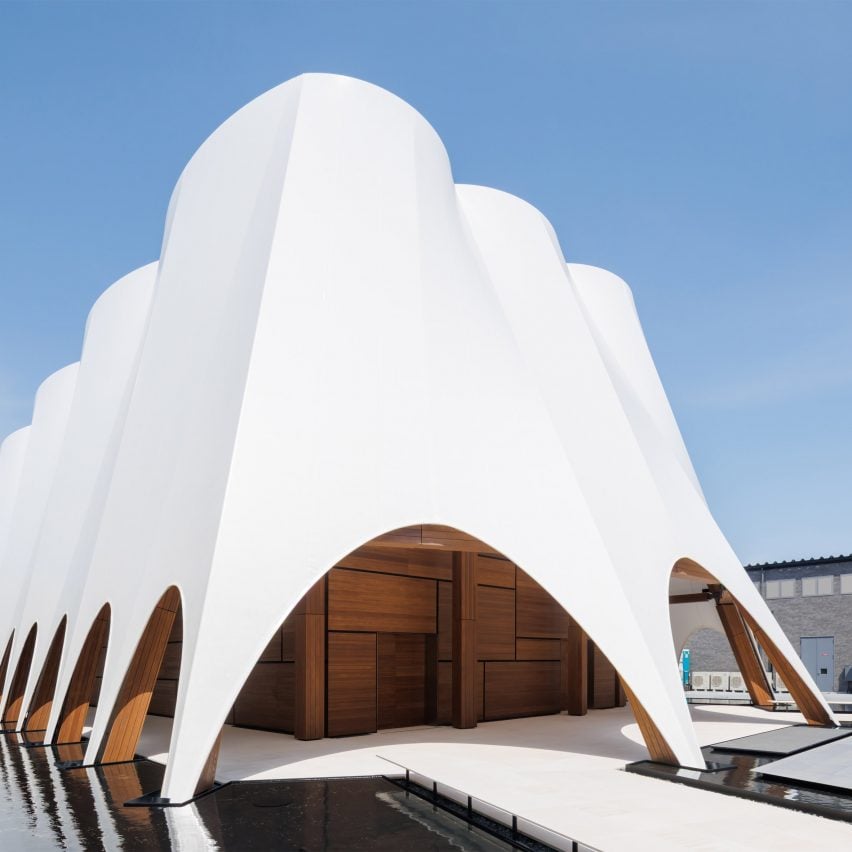Architecture studio Kengo Kuma and Associates stretched white fabric over a scalloped timber structure for the Qatar Pavilion at the Expo 2025 Osaka, which contains an exhibition designed by Dutch studio AMO.
Aiming to evoke maritime forms, Kengo Kuma and Associates drew upon traditional dhow sailing vessels for the pavilion.

The pavilion has a timber structure made with Qatari and Japanese joinery techniques, which was wrapped in a curving white fabric facade reminiscent of dhow sails.
Commissioned by Qatar’s Ministry of Commerce and Industry with creative direction by Qatar Museums think tank Qatar Blueprint, arched openings in the fabric facade reveal a walkway encircling the wooden building.

Kengo Kuma and Associates’ pavilion houses an exhibition designed by AMO, the research and creative studio of Dutch architecture firm OMA.
Titled From the Coastline We Progress, the exhibition aims to explore how Qatar’s coastline has influenced the country’s culture, identity and industry.

“We chose to tell the story of Qatar through its coastline: the place where people who visited the country would first set foot on land, and from where people departed for either pearling or fishing,” AMO director Samir Bantal told Dezeen.
“Ninety-nine per cent of Qatar’s people live, work, and recreate along the coastline,” he continued. “It’s where its main infrastructure of economy, culture, and preservation takes place.”
The exhibition is divided into 12 zones, including a central cinema room with draping fabric walls designed by AMO in collaboration with architecture studio Inside Outside.
Titled Sea Curtain, patterns on the fabric walls represent maritime boundaries surrounding Qatar, which aim to highlight the complexity of human and non-human environments.

In the middle of the space is a cinema screen divided into three horizontal strips that display an AMO-directed film on Qatar’s history, featuring shots of archaeological sites, natural reserves, ecological habitats and coastal cities.
Partition walls surround the screen and viewing area, designed to mimic sand dunes and create a sense of sanctuary from the rest of the exhibition.

“The central space of the exhibition was inspired by the winter camps where many Qataris spend significant time away from the buzz of the city,” Bantal said.
“In this geometric representation of the dunes, we created a cinema space, as a retreat from the many efforts of the coastline.”

Elsewhere at the Expo 2025 Osaka, Lebanese architect Lina Ghotmeh created a 17-metre-tall timber structure for the Bahrain Pavilion, which was also informed by dhow boats.
All of the pavilions at the expo are contained within a ring-shaped wooden structure designed by Japanese studio Sou Fujimoto Architects, which has been named the world’s largest wooden structure.
The photography is by Iwan Baan unless otherwise stated.
Expo 2025 Osaka takes place in Osaka until 13 October 2025. For more fairs, events and talks in architecture and design, visit Dezeen Events Guide.
The post Kengo Kuma models Qatar Pavilion on traditional sailing boats appeared first on Dezeen.

